In today’s fast-moving world of software development, keeping our code clean, secure, and efficient is more important. While manual code reviews are great for catching issues, they can take a lot of time & even then, some problems might slip through.
This blog shows how to build a lightweight, automated code review system using AWS Bedrock and AWS Lambda. With AI-powered analysis, it checks our code for bugs, security flaws, performance issues, and style tips—without needing heavy infrastructure. It’s fast, innovative, and cost-effective.
Why We Use Automated Code Review
Our automated code review system solves these problems by providing instant, AI-powered feedback. It quickly analyses code for bugs, security flaws, performance issues, and style improvements. Built on a serverless, pay-per-use model, it’s cost-effective and requires no infrastructure management. The AI ensures consistent quality across all reviews and is available 24/7. Whether you’re reviewing a single function or an entire file, the system scales effortlessly and integrates smoothly into our existing development workflow.
Prerequisites
- AWS Services: API Gateway, Lambda, Bedrock
- Development: Python 3.9+, code editor (e.g., VS Code), curl/Postman
- Knowledge: Basics of AWS, Python, REST APIs, and JSON
Architecture Diagram
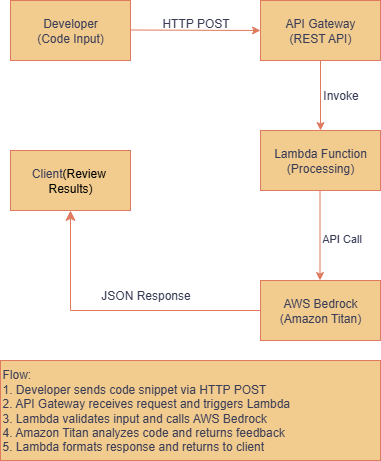
How to Implement an Automated Code Review System with AWS Bedrock and AWS Lambda
Step 1: Lambda Function Implementation
To get started, first create an IAM role for the Lambda function with the correct permissions, mainly access to AWS Bedrock. Then, set up a Lambda function using Python 3.9 or above. We will create it from scratch in the AWS Console, where we will write the logic to handle incoming code, prepare it for analysis, and connect to the AI model via Bedrock.
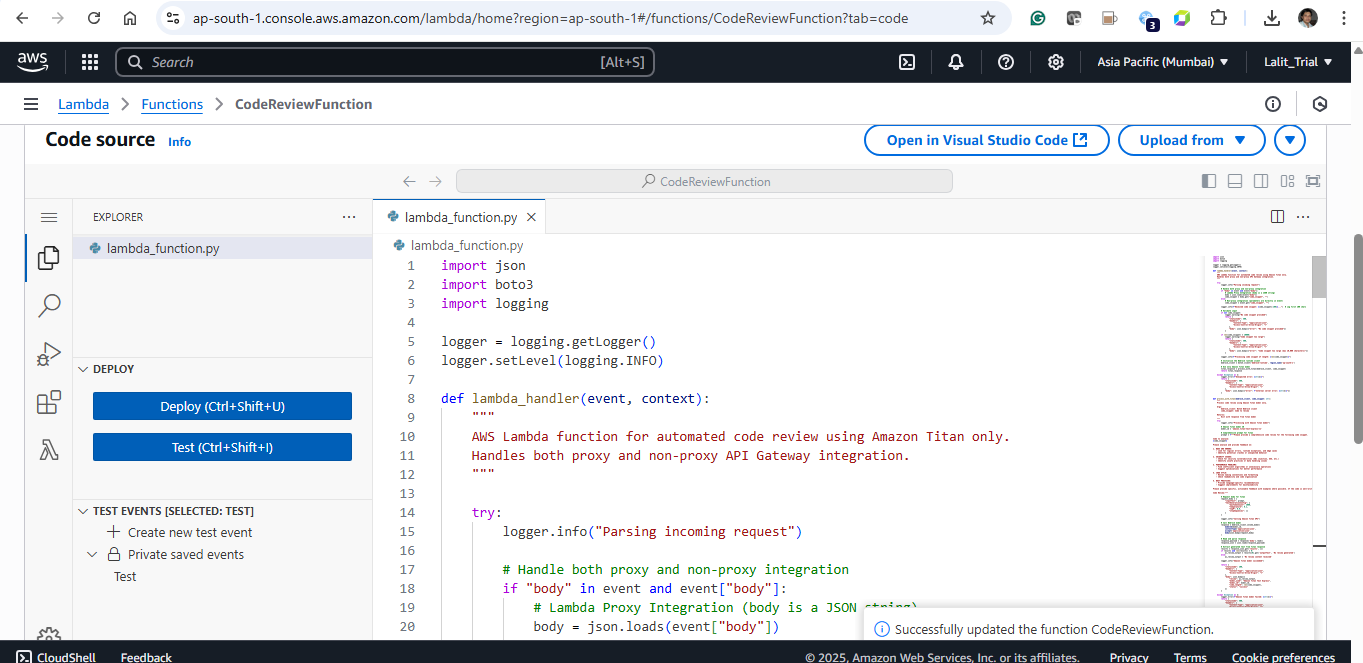
Step 2: API Gateway Configuration
Next, set up a REST API in AWS API Gateway. Create a /review resource and add a POST method to handle incoming code submissions. Link this method to the Lambda function using proxy integration, so the whole request is passed through. Finally, deploy the API to a production stage to make it live and ready for use.
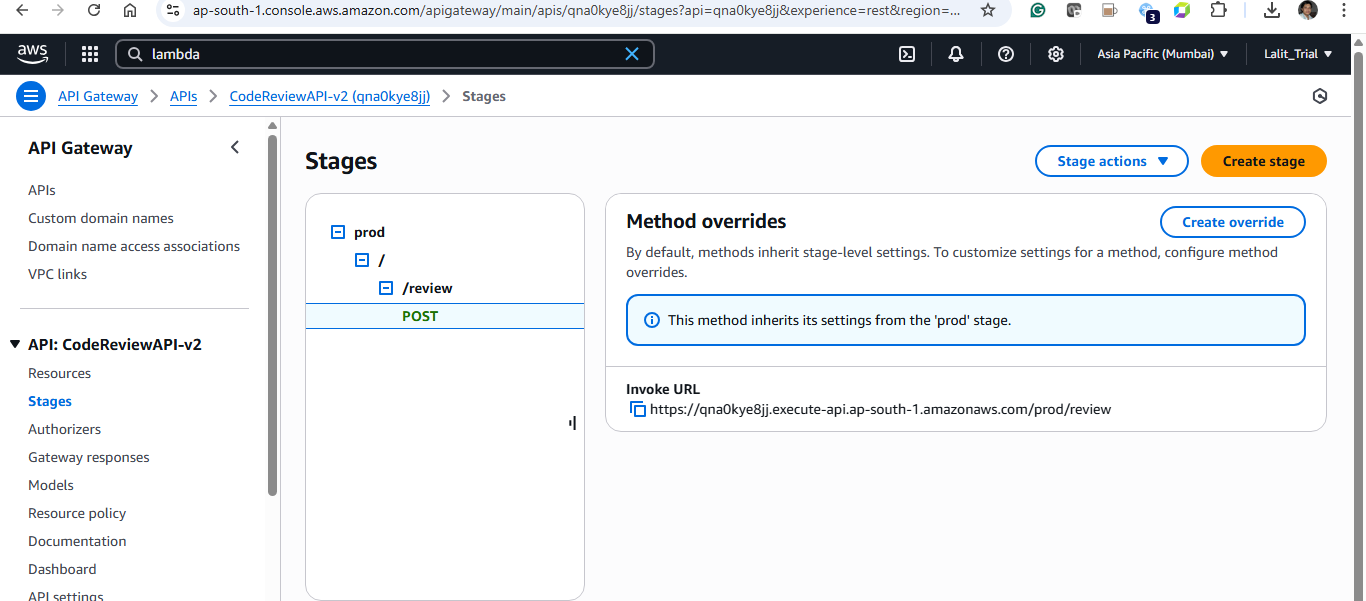
Step 3: Build the Lambda function
To test the setup and see how Amazon Bedrock responds to different types of code, you can run the following examples using curl / Postman.
Example 1: Basic Function Test
This sends a simple addition function to check if the system responds correctly.
curl -X POST
https://your-api-id.execute-api.region.amazonaws.com/prod/review
-H "Content-Type: application/json"
-d '{"code_snippet": "def add(a, b):n return a + b"}'
Example 2: Bug Detection Test
This tests how the system handles a division by zero error.
curl -X POST
https://your-api-id.execute-api.region.amazonaws.com/prod/review
-H "Content-Type: application/json"
-d '{"code_snippet": "def divide(a, b):n return a / bnnresult = divide(10, 0)"}'
Example 3: Security Vulnerability Test
These checks for SQL injection risks in a query-building function.
curl -X POST
https://your-api-id.execute-api.region.amazonaws.com/prod/review
-H "Content-Type: application/json"
-d '{"code_snippet": "def get_user(user_id):n query = "SELECT * FROM users WHERE id = " + user_idn return execute_query(query)"}'
Make sure to replace your-api-id and region with actual API Gateway details. We will get the below OUTPUT as shown in the screenshots below.
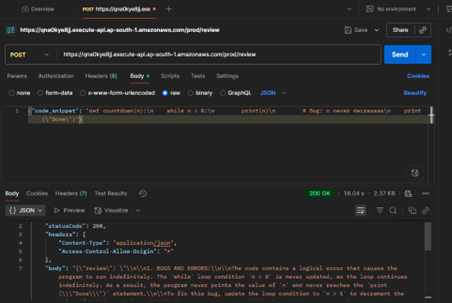
AI Review for the code will show in the Body Section.

Seamless Integration with GitHub, VS Code, and Web Interface
The code review system can be further easily integrated into our development workflow. You can connect it with GitHub to trigger automated reviews on pull requests, use it within VS Code through extensions or REST API calls for instant feedback while coding, and even build a simple HTML interface to paste and test code snippets directly in the browser. This makes it accessible and useful across different stages of development.
Below is the representation of integration with HTML.
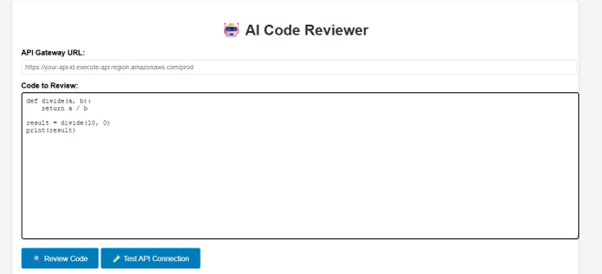
Results and Impact
The AI-powered code review system effectively identifies a wide range of issues, including runtime errors like division by zero, security vulnerabilities such as SQL injection, performance inefficiencies, and code style problems. It also promotes best practices like proper documentation and error handling. When integrated into development workflows, teams have seen up to a 50% reduction in manual review time, earlier bug detection, consistent code quality across developers, and valuable learning support for junior team members.
Conclusion
We’ve successfully built a production-ready, automated code review system that’s both efficient and scalable. Using advanced AI models through AWS Bedrock, the system delivers deep code analysis covering bugs, security risks, performance issues, and style improvements. Thanks to AWS’s serverless architecture, it remains cost-effective and easy to maintain. Its REST API design allows smooth integration with existing tools and workflows, while the use of managed services ensures scalability and reliability without infrastructure headaches.
Source: Read MoreÂ
